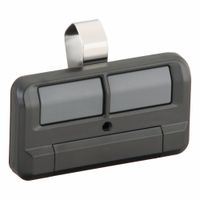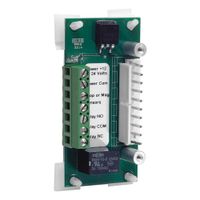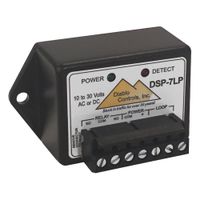Call +(254) 703 030 000 / 751 483 999 / 721 704 777
- Home
- Security
- Access Barriers Crowd Control
- Gate Operator Systems Vehicle Detectors
.....Read More
Frequently Asked Questions
How do gate operator systems work?
Gate operator systems function by automating the opening and closing of gates, typically using electric motors. These systems are controlled by a combination of hardware and software components that work together to ensure smooth operation.
1. **Power Source**: Gate operators are powered by electricity, either from the main power supply or solar panels. Backup batteries are often included to ensure functionality during power outages.
2. **Motor**: The core component is an electric motor, which provides the mechanical force needed to move the gate. The motor's power and type (AC or DC) depend on the gate's size and weight.
3. **Control Panel**: This is the system's brain, housing the circuit board that processes signals from remote controls, keypads, or sensors. It manages the motor's operation, ensuring the gate opens and closes correctly.
4. **Remote Controls and Keypads**: Users can operate the gate using remote controls or keypads. These devices send signals to the control panel to initiate gate movement.
5. **Sensors and Safety Devices**: Safety is paramount, so gate systems include sensors like photo eyes or edge sensors to detect obstacles. If an obstruction is detected, the system halts or reverses the gate to prevent accidents.
6. **Limit Switches**: These are used to define the gate's open and closed positions, ensuring it stops at the correct points.
7. **Drive Mechanism**: Depending on the gate type (swing, slide, or barrier), different drive mechanisms like chains, belts, or gears are used to transfer the motor's power to the gate.
8. **Communication Systems**: Modern systems may include Wi-Fi or Bluetooth connectivity, allowing users to control the gate via smartphones or integrate it with smart home systems.
Overall, gate operator systems combine mechanical and electronic components to provide secure, convenient access control.
What are the benefits of using a gate operator system?
A gate operator system offers numerous benefits, enhancing security, convenience, and property value. Firstly, it significantly boosts security by controlling access to a property, deterring unauthorized entry, and providing a physical barrier against intruders. Many systems come with advanced features like keypads, remote controls, and intercoms, allowing for secure and controlled access.
Convenience is another major advantage. With a gate operator, users can open and close gates without leaving their vehicles, which is particularly beneficial during adverse weather conditions. This ease of use is further enhanced by automation features, such as scheduled opening and closing times, which can be programmed to suit the user's lifestyle.
Gate operator systems also contribute to increased property value. A well-installed system adds a layer of sophistication and modernity, making the property more attractive to potential buyers. It also suggests that the property is well-maintained and secure, which can be a significant selling point.
Additionally, these systems offer privacy by restricting visibility and access to the property, creating a more secluded and personal environment. This is particularly appealing for residential properties where privacy is a priority.
Moreover, gate operators can be integrated with smart home systems, allowing for remote monitoring and control via smartphones or other devices. This integration provides real-time alerts and the ability to manage access from anywhere, enhancing both security and convenience.
Finally, gate operator systems can reduce insurance premiums. Many insurance companies offer discounts for properties with enhanced security features, recognizing the reduced risk of theft or vandalism.
In summary, gate operator systems provide enhanced security, convenience, increased property value, privacy, smart integration, and potential insurance savings, making them a valuable investment for both residential and commercial properties.
How do vehicle detectors integrate with gate operator systems?
Vehicle detectors integrate with gate operator systems by using sensors to identify the presence of a vehicle and then sending signals to the gate operator to open or close the gate accordingly. These detectors can be loop detectors, infrared sensors, or magnetic sensors.
1. **Loop Detectors**: These are the most common type and consist of an inductive loop of wire embedded in the pavement. When a vehicle passes over or stops on the loop, it changes the loop's inductance, triggering the detector. The detector then sends a signal to the gate operator to open or close the gate.
2. **Infrared Sensors**: These sensors use infrared light to detect vehicles. They can be mounted above ground and work by emitting an infrared beam. When a vehicle interrupts the beam, the sensor sends a signal to the gate operator.
3. **Magnetic Sensors**: These are installed on or under the road surface and detect changes in the earth's magnetic field caused by a vehicle. When a vehicle is detected, the sensor sends a signal to the gate operator.
The integration process involves connecting the output of the vehicle detector to the input of the gate operator system. The gate operator is programmed to respond to the signals from the detector, ensuring the gate opens when a vehicle is detected and closes after the vehicle has passed.
Additionally, these systems can be integrated with access control systems, such as keypads or RFID readers, to enhance security. The vehicle detector ensures the gate only opens when a vehicle is present, while the access control system verifies the vehicle's authorization to enter.
Overall, the integration of vehicle detectors with gate operator systems enhances convenience, security, and traffic flow management.
What are the different types of gate operator systems available?
There are several types of gate operator systems available, each designed to suit different needs and gate types:
1. **Swing Gate Operators**: These are used for gates that open inward or outward, like a door. They can be single or double swing operators, depending on whether the gate has one or two leaves. They are ideal for residential driveways and can be powered by hydraulic or electromechanical systems.
2. **Sliding Gate Operators**: Suitable for gates that slide horizontally along a track. These operators are often used in commercial and industrial settings due to their ability to handle heavy gates. They are space-efficient, as they do not require the space that swing gates need to open.
3. **Barrier Gate Operators**: Commonly used in parking lots and toll booths, these operators control a barrier arm that raises and lowers to allow or block vehicle access. They are designed for high-frequency use and can be operated manually or automatically.
4. **Overhead Gate Operators**: Used for gates that lift vertically, similar to a garage door. These are less common but are useful in areas with limited horizontal space.
5. **Vertical Pivot Gate Operators**: These systems allow the gate to pivot vertically, similar to a railroad crossing arm. They are suitable for areas with limited space and can be used in both residential and commercial settings.
6. **Bi-Folding Gate Operators**: Designed for gates that fold in the middle, allowing for quick opening and closing. They are ideal for areas with limited space and require less room to operate compared to swing gates.
7. **Cantilever Gate Operators**: These are similar to sliding gates but do not require a track on the ground. The gate is supported by rails that run along the fence line, making them ideal for uneven terrain or areas prone to snow and debris.
How do I troubleshoot common issues with gate operator systems?
To troubleshoot common issues with gate operator systems, follow these steps:
1. **Power Supply Check**: Ensure the gate operator is receiving power. Check the circuit breaker, fuses, and power connections. Replace or reset as necessary.
2. **Remote Control Issues**: Replace remote batteries and ensure the remote is programmed correctly. Test the remote's range and check for interference from other devices.
3. **Manual Operation**: Disengage the operator and manually open the gate to check for physical obstructions or mechanical issues like misalignment or damaged rollers.
4. **Sensor and Safety Device Inspection**: Clean and align photo-eye sensors. Ensure safety loops and edge sensors are functioning. Test for obstructions and recalibrate if needed.
5. **Limit Switches**: Check and adjust limit switches to ensure the gate opens and closes fully. Misaligned switches can cause the gate to stop prematurely.
6. **Control Board Examination**: Inspect the control board for visible damage or burnt components. Reset the board if possible and check for error codes.
7. **Motor and Gearbox**: Listen for unusual noises from the motor or gearbox, indicating wear or damage. Lubricate moving parts and replace worn components.
8. **Wiring and Connections**: Inspect all wiring for damage or loose connections. Tighten or replace as necessary.
9. **Environmental Factors**: Check for weather-related issues like ice, snow, or debris that may impede operation. Ensure the gate is weatherproofed.
10. **Software and Settings**: Verify that the operator's software is up-to-date. Reprogram settings if the gate behaves erratically.
11. **Professional Assistance**: If issues persist, consult the manufacturer's manual or contact a professional technician for advanced diagnostics and repairs.
What safety features should a gate operator system have?
A gate operator system should incorporate several safety features to ensure secure and reliable operation:
1. **Obstacle Detection**: The system should have sensors to detect obstacles in the gate's path, preventing it from closing on vehicles, people, or objects. This can include infrared sensors, pressure sensors, or ultrasonic sensors.
2. **Auto-Reverse Mechanism**: If the gate encounters an obstruction while closing, it should automatically reverse direction to prevent injury or damage.
3. **Manual Release**: In case of power failure or system malfunction, a manual release mechanism should be available to allow the gate to be operated manually.
4. **Emergency Stop**: An emergency stop button should be accessible to immediately halt gate operation in case of an emergency.
5. **Warning Signals**: Audible alarms or flashing lights should be used to alert users when the gate is in motion, especially in high-traffic areas.
6. **Safety Edges**: These are pressure-sensitive strips installed on the leading edge of the gate that stop and reverse the gate if contact is made with an object.
7. **Photoelectric Eyes**: These are beam sensors that stop the gate if the beam is broken, indicating an obstruction in the gate's path.
8. **Speed Control**: The system should have adjustable speed settings to control the gate's opening and closing speed, reducing the risk of accidents.
9. **Secure Access Control**: The system should include secure access methods such as keypads, card readers, or remote controls to prevent unauthorized access.
10. **Battery Backup**: A battery backup system ensures the gate can operate during power outages, maintaining security and functionality.
11. **Weather Resistance**: The system should be designed to withstand various weather conditions, ensuring consistent performance and safety.
12. **Regular Maintenance Alerts**: The system should provide alerts for regular maintenance checks to ensure all safety features are functioning correctly.
How do I maintain and service a gate operator system?
To maintain and service a gate operator system, follow these steps:
1. **Regular Inspection**: Conduct monthly visual inspections for wear and tear. Check for loose bolts, rust, and any physical damage to the gate and operator.
2. **Lubrication**: Lubricate moving parts such as hinges, chains, and rollers every six months. Use a silicone-based lubricant to prevent dust accumulation.
3. **Electrical Components**: Inspect wiring and connections for signs of corrosion or damage. Ensure that the control box is sealed properly to prevent moisture ingress.
4. **Safety Features**: Test safety features like photo-eye sensors and edge sensors monthly. Ensure they are clean and aligned correctly to prevent false triggers.
5. **Battery Maintenance**: For battery-operated systems, check the battery charge and terminals every three months. Replace batteries as needed to ensure reliable operation.
6. **Motor and Gearbox**: Listen for unusual noises from the motor or gearbox, which may indicate wear. Check for oil leaks and ensure the gearbox is adequately lubricated.
7. **Limit Switches**: Test and adjust limit switches to ensure the gate opens and closes fully without over-traveling, which can strain the motor.
8. **Remote Controls**: Replace remote control batteries annually and reprogram them if they fail to operate the gate.
9. **Weatherproofing**: Ensure all components are weatherproofed, especially in areas prone to extreme weather. Check seals and covers for integrity.
10. **Professional Servicing**: Schedule annual professional servicing to address complex issues and perform comprehensive checks.
11. **Documentation**: Keep a maintenance log detailing inspections, servicing, and any repairs conducted. This helps in tracking the system’s health and planning future maintenance.
By following these steps, you can ensure the longevity and reliable operation of your gate operator system.



